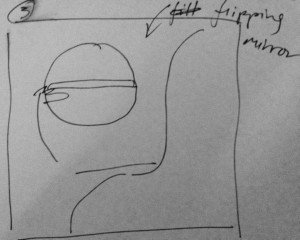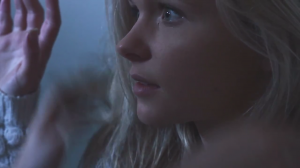For week 7’s shoot I decided to use Nicholas Winding Refn’s style of shooting that I wrote about in My Method of Working Part 4. This was the beginning of my individual investigation and the first scene we had to shoot outside of class. I loved this because I got to use my own camera, which I am a lot more comfortable with in comparison to the Sony EX3s we generally use in class. The problem with this was that because I was shooting on a DSLR camera there was no viewfinder (only a digital display screen) and the in-built microphone produced pretty appalling audio.
The night before shooting I had a look over the prose (not script) I was working off and found a location for the scene. I then quickly drew some ideas onto cue cards so that I could show the actors what I wanted the shots to roughly look like while on set. These were not shot by shot storyboards, they were literally just random concepts I thought might work well on screen.
On the day of the actual shoot I found that there were some definite advantages and disadvantages to this method of filming. I think shooting in chronological order is a good idea when implementing such an organic process of shooting. I found that this method helped me to come up with new ideas while I was on set because I was readily responding to how the actors were using the space and how they were reacting to each other. If I had not shot the sequence in chronological order, I could not have so readily included new ideas into the scene.
For instance, the first shot was a complete fluke. Even if I had properly storyboarded this scene beforehand, there is no way I would have come up with a shot like this. For some reason, on that day outside, there was a beautiful light, which was just catching on the trees. Somehow I found some leaves that framed the shape of the character’s head perfectly and so I decided to shift the focus from the leaves to the character, which created a smooth transition, drawing the audience into the scene.

Coincidentally, exactly where I wanted to put the tripod there was a concrete garden bed, which made it impossible to stabilise the tripod. However, this (I think) worked to my benefit. Having a quick look through the camera, I realised that a slightly hand held style would emulate a voyeuristic point of view shot (as if someone was staring at the character from behind the tree). This shot essentially established the entire tone of the scene: slightly creepy, awkward and tense.
Having the cue cards helped to give me some direction while I was shooting and they became a springboard for other ideas. I had mainly drawn out frames that explored how I could use the mirrors in the location. However (as you can see below), a lot of those original concepts did not eventuate. This was either because I realised they wouldn’t work once I got on set, they didn’t suit the tone I was going for or they ended up morphing and developing into different ideas. In some ways I think this kind of general planning is better than definitive storyboards. Often I feel like I have to follow a plan when it is put in front of me, which makes it difficult to think of other ways of possibly covering the scene.






Nevertheless, there were some downfalls to this method. Firstly, although I was using my own camera and I was only working with a very small cast of friends, I did not feel overly confident or comfortable during the shooting process. Maybe it was because I am not used to improvising on set, particularly when I’m the one making all of the decisions, but I found myself constantly apologising to the actors. I felt like I was wasting their time, because I was running around trying to find ‘the shot’ and they had to stand there waiting. Sometimes I’d start recording a take and then I’d stop everything because I didn’t like it or I had thought of a better way to cover it. During these instances I just felt a bit all over the place, like the shoot was a complete mess. It became a heavily emotional process, which was not necessarily all good or all bad. When I completely plan out a scene before going into a shoot, I feel like there is a sense of separation between me and and what is being recorded, because it has already been predetermined in a way. Whereas with this more improvisational approach, I was so intensely involved in everything that was being shot that it really affected how I felt. If something wasn’t working, I would get really upset/annoyed/angry, because there was no plan to rely on. Conversely, if something turned out well, I would be overjoyed. I distinctly remember when the shot below was recorded. By this point in the shoot, the actors were working really well together, the light was just right and I was happy with the framing. I was so thrilled with this take that I got the actors to come and look at it on the camera and I decided that it was perfect, so we moved straight onto another shot. In retrospect, I really should have done another take because that was the hardest shot to colour grade (I had been having lighting problems throughout the shoot because my only source was daylight and the weather conditions had been changing every few minutes). Thus there are pros and cons to becoming so emotionally involved with a project.


It probably would have been better to have a crew that could help me operate the camera and audio, so then I could have solely focused on directing. However, with this method of shooting, I felt like I really needed to be looking through the camera at all times so that I could physically move it around to find the framing I wanted. This method was so far removed from Hitchcock’s style of shooting where everything was rigorously planned out in advance so that he never actually needed to look through the viewfinder of the camera. In reality I think that I might have felt even more uncomfortable having a bigger crew, because it would have meant that there would have been more pressure on me to direct everyone and keep the shoot running at a decent pace.
Subsequent to filming and editing, I have thought of different compositions and framing techniques I could have used and I wonder that if I had have spent more time in pre-production whether I would have thought of these and been able to implement them into my work. Although I think this organic process of filmmaking is great, as a director using this method, you have to be willing to accept that sometimes you are going to miss things simply because your mind isn’t given enough time to thoroughly think through the scene. I think that sometimes letting your mind stew on an idea for a while can help to develop the concept; I’m no psychologist, but I know when you are struggling to think of something, your subconscious will continue to work in the background to try to solve the problem. In the end, it really just comes down to spontaneity verses planning. At this stage, I’m still not sure which side of the spectrum I favour, but I guess that is what my entire investigation is about.
On the whole, I was actually pretty happy with how the footage came together in the edit. I think I still have a long way to go until I find the best shooting methodology for me, but overall I really liked the idea of shooting a scene chronologically and sketching rough ideas of how the scene might look before going ‘on set’. Ultimately I would like to work these processes into my final method of shooting.

